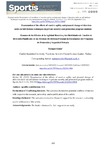Mostrar o rexistro simple do ítem
Examination of the Effects of Reactive Agility and Planned Change of Direction Skills on Self Defense Techniques in Private Security and Protection Program Students
| dc.contributor.author | Söyler, Mehmet | |
| dc.date.accessioned | 2022-11-23T16:16:33Z | |
| dc.date.available | 2022-11-23T16:16:33Z | |
| dc.date.issued | 2022-09-01 | |
| dc.identifier.citation | Söyler, M. (2022). Examination of the effects of reactive agility and planned change of direction skills on self defense techniques in private security and protection program students. Sportis Sci J, 8 (3), 309-328 https://doi.org/10.17979/sportis.2022.8.3.9008 | es_ES |
| dc.identifier.issn | 2386-8333 | |
| dc.identifier.uri | http://hdl.handle.net/2183/32115 | |
| dc.description.abstract | [Abstract] The purpose of this study is investigate the impact of reactive agility, reaction-based planned change of direction training on the practice of self defence methods among students enrolled in the Private Security and Protection program of Vocational Schools. Twenty male volunteer students, 21.20±1.28 years, height 177.37±6.18 cm, weight 75.56±5.50 kg, voluntarily participated in the study. While the volunteer research group received reactive agility, response speed training for 2 hours 4 days a week for 8 weeks, the control group continued to receive self defence skills instruction as usual. Measurements of body composition Body analyzer Inbody 270 (Japan), reactive test Fitspeed (Turkey) gadget for measuring agility performance, as well as other agility planned change of direction tests Fusion Smart (Australia) with an integrated system of photocell doors, T Test digital integrated system stopwatch (Belgium), Reaction time Speed test was measured using a Performanz Spark test equipment (Turkey). The SPSS 22 software was utilized to analyze the data. First, the data distribution was evaluated using the Shapiro-Wilk test, it was discovered that it did not have a normal distribution. Mann Whitney U Tests were used in this manner to find the difference between the pre-test and post-test results of the nonparametric Wilcoxon Signed Rank Test across groups in order to determine the difference between the pre-post-test data within the group. The level of significance in the study was determined at p>0.05. According to the statistical analysis, the 8-week planned change of direction, reactive agility training improved the response speed, agility performance of the work group students (p>0.05) | es_ES |
| dc.description.abstract | [Resumen] El propósito de este estudio es investigar el impacto de la agilidad reactiva, el entrenamiento de cambio de dirección planificado basado en la reacción en la práctica de métodos de defensa personal entre los estudiantes matriculados en el programa de Protección y Seguridad Privada de las Escuelas Vocacionales. Veinte estudiantes voluntarios varones, 21,20 ± 1,28 años, altura 177,37 ± 6,18 cm, peso 75,56 ± 5,50 kg, participaron voluntariamente en el estudio. Mientras que el grupo de investigación voluntario recibió entrenamiento de agilidad reactiva y velocidad de respuesta durante 2 horas, 4 días a la semana durante 8 semanas, el grupo de control continuó recibiendo instrucción en habilidades de defensa personal como de costumbre. Mediciones de composición corporal Analizador corporal Inbody 270 (Japón), test reactivo Fitspeed (Turquía) Gadget para medir el rendimiento de agilidad, así como otras pruebas de cambio de dirección planificado de agilidad Fusion Smart (Australia) con un sistema integrado de puertas de fotocélula, T Test digital cronómetro de sistema integrado (Bélgica), tiempo de reacción La prueba de velocidad se midió utilizando un equipo de prueba Performanz Spark (Turquía). Se utilizó el software SPSS 22 para analizar los datos. Primero se evaluó la distribución de datos mediante la prueba de Shapiro-Wilk, se descubrió que no tenía una distribución normal. Las pruebas U de Mann Whitney se utilizaron de esta manera para encontrar la diferencia entre los resultados previos y posteriores a la prueba de la prueba no paramétrica de rangos con signos de Wilcoxon entre los grupos para determinar la diferencia entre los datos previos y posteriores a la prueba dentro del grupo. El nivel de significación en el estudio se determinó en p>0,05. De acuerdo con el análisis estadístico, el cambio de dirección planificado de 8 semanas, el entrenamiento de agilidad reactiva mejoró la velocidad de respuesta, el rendimiento de agilidad de los estudiantes del grupo de trabajo (p>0.05) | es_ES |
| dc.language.iso | eng | es_ES |
| dc.publisher | Universidade da Coruña | es_ES |
| dc.relation.uri | https://doi.org/10.17979/sportis.2022.8.3.9008 | es_ES |
| dc.rights.uri | https://creativecommons.org/licenses/by-nc-nd/4.0 | |
| dc.subject | Defensa | es_ES |
| dc.subject | Entrenamiento | es_ES |
| dc.subject | Agilidad | es_ES |
| dc.subject | Reacción | es_ES |
| dc.subject | Defense | es_ES |
| dc.subject | Training | es_ES |
| dc.subject | Agility | es_ES |
| dc.subject | Reaction | es_ES |
| dc.title | Examination of the Effects of Reactive Agility and Planned Change of Direction Skills on Self Defense Techniques in Private Security and Protection Program Students | es_ES |
| dc.title.alternative | Examen de los efectos de la agilidad reactiva y las habilidades de cambio de dirección planificado en las técnicas de defensa personal en estudiantes del programa de protección y seguridad privada | es_ES |
| dc.type | info:eu-repo/semantics/article | es_ES |
| dc.rights.access | info:eu-repo/semantics/openAccess | es_ES |
| dc.date.updated | 2022-11-22T16:15:48Z | |
| UDC.journalTitle | Sportis. Scientific Journal of School Sport, Physical Education and Psychomotricity | es_ES |
| UDC.volume | Vol. 8 | es_ES |
| UDC.issue | Núm. 3 | es_ES |
| UDC.startPage | 309 | es_ES |
| UDC.endPage | 328 | es_ES |
| dc.identifier.doi | 10.17979/sportis.2022.8.3.9008 |






